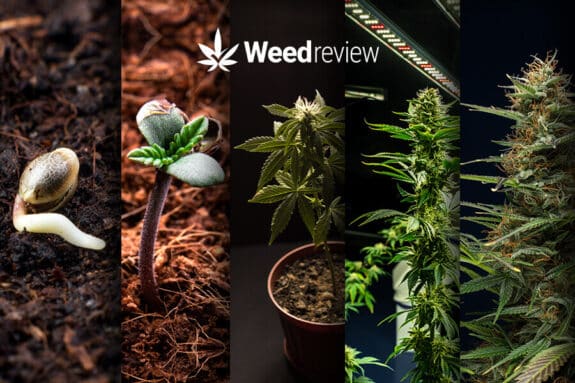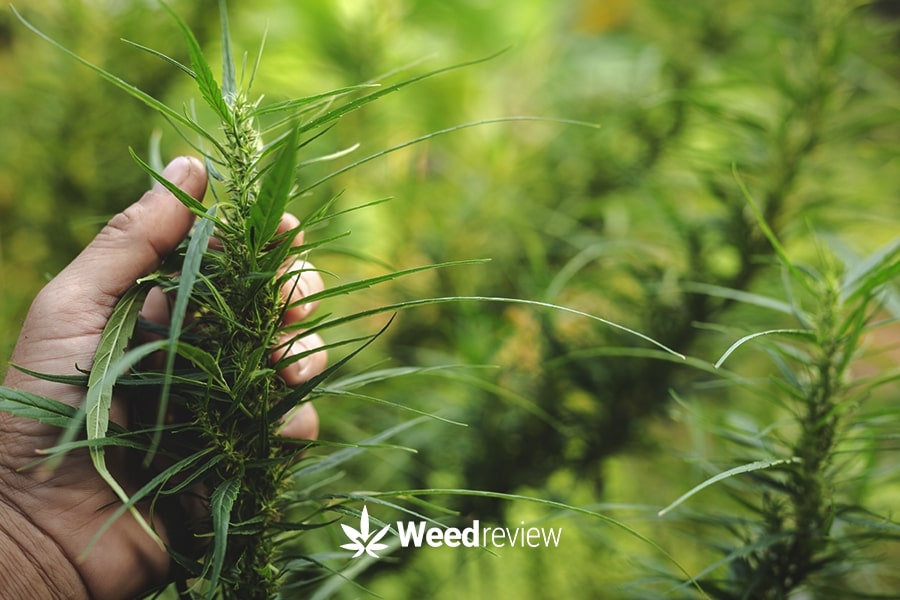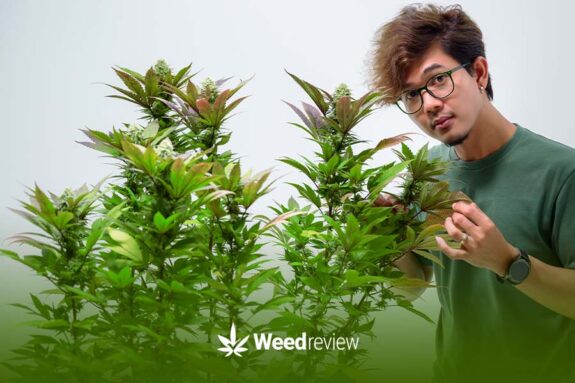
How to Grow Cannabis: A Beginner’s Guide to Growing Marijuana

Table of Contents
Growing cannabis at home is easy to learn but difficult to master. It requires a little bit of your time every day and dedicated growing space.
Trying and learning everything can be overwhelming if you’re just starting out. It is better to familiarise yourself with the fundamentals of growing marijuana first before diving in deeply.
This introductory guide from Weed Review will teach you everything you need to know to grow medicinal cannabis flowers successfully. In this beginner’s guide to growing weed, we will look at aspects like:
- Type of strains and seeds
- Technical requirements – soil, nutrient, lighting
- Indoor grow vs. outdoor grow
- Growing phases
By the end of this article, you will be in a position to do what is needed to grow your own buds at home.
Understanding the cannabis plant
The main goal of growing cannabis is to harvest the flowers it produces. These buds are what people will consume, either by smoking or turning them into edibles and concentrates.
To produce these buds in the highest quality possible, there are a few concepts you should know.
Male and female plants – why does it matter?
Cannabis has both male and female plants with different characteristics for each. A general growing rule is that you always want female plants in your garden as they produce flowers.

Male plants will produce pollen that germinates the female flowers, giving you seeds instead. While that’s great if you’re a cannabis breeder, it doesn’t give you quality, top-shelf flowers.
It is important to identify and remove male plants from your gardens immediately. This can be done early in the growing cycle, usually when the plant reaches sexual maturity.
Identification
You can identify the sex of the plants within 3-6 weeks of seeds sprouting. Male plants will mature and develop pre-flowers two-three weeks before females.
The key is to look at the base of each branch near the stalk. These are called “nodes” and are where new growth occurs. You will know they’re males by the tight green clusters that grow at each node. They are pollen sacs that will be ready to open in a short time.
Female plants won’t have those green growths; instead, they will have a small white hair-like growth coming out from each side of the node.
Indica, Sativa, hybrids: Which one to choose?
The three major types of cannabis strains are Indica, Sativa, and hybrid. They have different growing requirements and genetic features; as a result, they can look very different from each other.
- Indica strains originated in the Afghan mountains, with a short growing season and cool climate. Indicas tend to be shorter and bushier than Sativa strains, reaching only up to 1-1.5 metres in height.
- Sativa strains traditionally came from closer to the equator, which is hotter and has a long growing season. These strains produce massive yields and grow very well outdoors, growing up to 4-6 metres tall.
- Hybrid cannabis strains are created by breeding one strain with another. The result has characteristics from both strains and highlights traits from the dominant genetics.
If you are growing indoors, Indica or Indica-leaning hybrids are recommended to start with. If you have plenty of space and are not worried about privacy, Sativa plants can fit you better. In addition, factors like yield, effects, and aroma you require in your plants will also play a role in this decision.
Autoflowering cannabis
This special type of cannabis is bred from a sub-species called Ruderalis and normal cannabis strains. Ruderalis is found in areas with very short growing seasons but many daylight hours.
Thanks to the short growing season, Ruderalis doesn’t rely on a photoperiod to start flowering, as other cannabis species’ do. Instead, they flower based on physical age instead of the photoperiod. This specific characteristic transfers over to autoflowering plants, making them easier to grow.
Cannabis seeds
The most common way to grow weed is from seeds. The type of seed you choose should be considered before you finish building the growing space.
There are a few different seed types to choose from, including:
- Regular: These are normal cannabis seeds that can be either male or female plants.
- Feminised: These seeds have a 100% chance of being female, flower-producing plants.
- Autoflowering: They produce autoflowering cannabis that doesn’t rely on a photoperiod to transition stages. You do not have to worry about light cycles with autoflowering seeds. This means you don’t have to worry about light cycles or lighting schedules.
- Strains: It is possible to buy specific strains that feature these attributes, in addition to having specific genetic traits like higher resilience to pests and diseases, less dependence on the environment, etc.
Should you grow indoors or outdoors?
A common question that marijuana growers ask is whether they should grow their plants indoors or outdoors. Both spaces have their own advantages and disadvantages; it will ultimately come down to your preferences and surroundings.

This comparison chart outlines the pros and cons of growing indoors and outdoors:
| Parameter | Indoor growing | Outdoor growing |
|---|---|---|
| Control of Environment | Offers precise control over conditions like light, temperature, and humidity. | Relies on natural conditions, limiting control. |
| Harvest Frequency | Allows multiple yearly harvests due to controlled conditions. | Typically limited to one annual harvest. |
| Privacy | Provides privacy as plants remain hidden. | Difficult to conceal, attracting attention. |
| Yield Quality | Produces consistent, high-quality cannabis. | Quality may vary based on environment and pests. |
| Initial Costs | Requires expensive equipment; higher startup costs. | Lower initial costs, relying on natural light. |
| Maintenance | Demands daily attention and adjustments. | Needs less daily upkeep, interacts with nature. |
| Cleanliness | Requires regular cleaning and ventilation. | Reduced need for complex cleaning. |
| Energy Usage | Uses electricity for lighting and climate control. | Utilizes natural sunlight, reducing costs. |
| Weather Dependence | Not affected by outdoor weather; stable environment. | Vulnerable to weather, pests, and diseases. |
Indoor grow
The main benefit of growing cannabis indoors is that you have complete control over the growing conditions. You can easily create the perfect climate and environment for the plants to produce larger yields. In addition, it is easier to monitor for pests and other diseases that may be more prevalent outdoors.
On the downside, the equipment for an indoor cannabis garden is one of the main expenses you’ll encounter.
Your list of expenses includes:
- Grow tents
- LED lights
- Humidifiers and fans
- Dehumidifiers (if applicable)
- Grow medium – hydroponic, soil, coco air, etc.
- Electricity costs
Our detailed guide lets you learn more about the specifics of growing weed indoors.
Indoor lighting requirements
Outdoor growers won’t have to think much about their lighting since the sun will take care of that. However, indoor growers have some choices when it comes to lighting. Since lighting directly affects the cannabis yields, it’s best not to cut corners.
- High-Pressure Sodium (HPS) and Metal Halide (MH) are known for their power and heat. This combination enables the plant to reach its full flower-producing potential. They are expensive to run since they require a lot of electricity.
- Light-emitting diode (LED) technology has greatly improved over the last decade. Some full-spectrum models emit light across the entire visible spectrum, much like the sun does. Additionally, they use much less electricity and substantially reduce production costs.
For more information, we suggest you check out our article on cannabis indoor grow lights.
Climate control
Indoor growers will have to consider how they want to monitor and control the environment for healthy growth. Here is what you need to consider:
- Temperature: For most cannabis strains, the ideal temperature range is between 21-29°C during the day and slightly cooler at night. Use an HVAC system or air conditioner (AC) to regulate and control the temperature within the grow space.
- Humidity: Controlling humidity levels is crucial to prevent mould and mildew issues. Use humidifiers to increase humidity and dehumidifiers to reduce it as needed.
- Air circulation: Proper air circulation helps maintain a healthy environment, preventing the buildup of stagnant air and minimising the risk of pests or diseases. Use fans and ventilation systems to ensure good airflow within the grow space and prevent heat spots on the plant.
- Light and dark cycles: Maintain consistent light and dark cycles to mimic natural daylight conditions. Typically, cannabis plants require 18 hours of light during the vegetative stage and 12 hours of uninterrupted darkness during the flowering stage. Use timers to automate the lighting schedule.
Outdoor grow
Starting an outdoor cannabis garden uses the sun to produce flowers. Doing it this way will save you a lot of money on electricity as the lighting and airflow are provided.
That said, unpredictable weather is a determining factor since heavy (or little) rainfall can cause root issues. Moreover, insects and other pests are common outdoors, potentially causing irreparable harm to your cannabis. To sum up, you don’t have much control over the environment.
Outdoor growers must consider the following:
- Choose the right strain that is resistant to diseases and pests. Many varieties are well-suited for local climates.
- Time your growing phase with seasonality in mind. Plan the planting and harvesting times, considering the climate when conditions are optimum for growth.
- Use physical structures like greenhouses, high tunnels (hoop houses), shade cloths, or large frames to protect from weather conditions like storms, winds, extreme sun, and rains.
- Mulch the soil to retain moisture and regulate the temperature of the growing medium.
To learn more, we recommend you check out our growing marijuana outdoors guide.
Growing outdoors in Thailand
Thailand’s tropical environment is perfect for growing cannabis outdoors. This is mainly due to the local temperature generally staying above 20 °Celcius. It is common to get multiple weed harvests a year in Thailand.
The average amount of rainfall in Thailand is between 1,200 to 4,500 mm per year. Cannabis only needs between 100-150 mm per year if grown outdoors in fertile soil.
Sativa strains will perform the best outdoors as they enjoy the hot heat and high humidity. Indica strains tend to grow best in cooler locations but will still grow in Thai climates.
Get started with growing cannabis at home
The first step is to ensure you have all of your equipment in place before you start growing.
For growing indoors, a basic setup looks like this:
- Growing tent or room
- Lights
- Pots
- Growing medium
- A fan
- Nutrients
- A watering system
An outdoor setup is much simpler, with things like:
- A pot
- A watering system
- Nutrients
The basic setup doesn’t require much, thanks to the resiliency of the cannabis plant. Just be sure to monitor it and adjust the environment as needed.
Growing medium
Choosing the right growing medium is fundamental for successful cannabis cultivation. There are several options to consider, each with its own advantages and disadvantages.

- Soil: Soil is the most common and beginner-friendly growing medium. It provides a natural environment for cannabis plants, containing a mix of organic matter, minerals, and microorganisms. Soil retains water well and provides a buffer for nutrient uptake.
- Coco coir: Coco coir is a popular alternative to soil. It is made from coconut husks and provides excellent water retention and aeration properties. Coco coir is also resistant to pests and diseases, making it a more reliable option for beginners.
- Hydroponics: Hydroponic systems use a nutrient-rich water solution instead of soil. This method allows for precise control over nutrient intake, resulting in faster growth and higher yields. However, hydroponics requires more technical knowledge and equipment. Any issues with the water solution can affect plant health.
Selecting the right growing medium depends on your experience level, available resources, and desired level of control. All options can yield successful results, so choose the one that aligns best with your preferences and goals as a beginner cannabis grower.
Understanding pH levels
pH levels are critical to successful cannabis cultivation. It tells us if the soil is acidic, neutral, or alkaline, affecting how plants absorb nutrients.
Soil typically thrives in a pH range of 6.0 to 7.0, while hydroponic systems prefer 5.5 to 6.5 pH. Straying from these ranges can lead to nutrient problems, affecting growth and yield.
Whether you choose soil or hydroponics, maintaining the correct pH balance is essential for healthy cannabis. Be aware of your medium’s specific pH needs, ensuring your plants can access nutrients efficiently. Proper pH management will help your cannabis thrive, resulting in robust growth and better yields.
Nutrients
Marijuana plants need a balanced diet full of vitamins and minerals.

Here is what you need to know as a grower about the food they eat:
- Macronutrients: Cannabis plants require three main macronutrients in large quantities – nitrogen (N), phosphorus (P), and potassium (K). They also need other macronutrients like calcium (Ca), magnesium (Mg), and sulfur (S).
- Micronutrients: Micronutrients are essential elements that cannabis plants require in smaller quantities. These include iron (Fe), manganese (Mn), zinc (Zn), copper (Cu), molybdenum (Mo), and boron (B).
- Organic vs. synthetic fertilisers: Organic options are derived from natural sources and provide slow-release nutrients, improving soil health over time. Common examples are manure, urine, bone meal, compost, etc. Synthetic fertilizers are chemically formulated and offer precise control over nutrient ratios but require careful use to avoid nutrient burn.
- Feeding schedule: Following a feeding schedule is crucial to ensure that your plants receive the right nutrients at each growth stage. Young plants have different nutrient requirements than flowering plants, so adjust your feed accordingly.
Nutrient requirements may vary depending on factors such as growing medium and strain. Keep an eye on your plants for signs of nutrient deficiencies or excesses to make sure your plants are eating correctly.
Different growing stages
Once you have all of your equipment and seeds ready to go, it’s time to start.

Germination: 3-8 days
To begin, put your cannabis seeds in a glass of water and keep them in a dark, warm place for up to 3 days. When you see a small, white root coming out of the seed, it’s time to plant it.
There are other ways to germinate seeds, like the paper towel method or using starter plugs/germination cubes.
Seedling stage: 2-3 weeks
At this stage, your cannabis has sprouted and is trying to establish some roots and its first leaves. All seedlings should be in a humid environment (60%-80%) with a temperature between 20°C-30°C and water as needed. This climate allows for rapid root development into the vegetative stage.
Indoor lighting should be on a timer set to 16 hours on and 8 hours off. One of the causes of failed seedlings is the light being too strong. A 16/8 light cycle will give the seedling a chance to respire when it’s off.
Vegetative stage: 4-10 weeks
The cannabis plant will start to develop large fan leaves and a strong root system to support future flower growth. Keep the temperature between 20°C and 30° and the humidity between 60%-75% for optimal growth.
Cannabis nutrients are necessary at this point to supplement the nitrogen needed to become larger. The light cycle should remain at 16 hours on and 8 hours off.
Flowering stage: 8-11 weeks
When the plants have reached a good size in the vegetation phase, it is time to activate the flowering stage.
Switch your light cycle to 12 hours on and 12 hours off. This change in the light cycle triggers hormonal responses within the plants, leading to the development of flowers. If you are using autoflowering seeds, you do not have to worry about it.
This is the longest stage, and you’ll want to provide ample phosphorus and potassium for flower growth.
Harvesting and drying
By the end of the flowering cycle, you should have long colas with huge buds at the end. Most regular cannabis strains will have their white pistils turn red, thus showing it is time to harvest.
The trichomes on the flowers are also a good indicator of harvesting. These are little globes filled with THC and other cannabinoids. If you look closely at the flowers and they are clear, then they are not ready to be harvested.
As they mature, the trichomes will turn milky and eventually into an amber colour as the cannabinoids start to break down. It is best to harvest your cannabis when there is a 50/50 split of milky and amber trichomes.
This is where you trim and cut the buds from the plant. You need to ensure as few leaves and stems on the flower – all the while preserving the trichomes and other goodness.
Drying time should take between 4-7 days if you keep the humidity under 40%. Don’t go too low, or they’ll dry too quickly and turn to dust. Once dried, transfer to an air-tight container.
Curing and storage
Curing preserves the cannabis flower for long-term storage by preventing moisture loss. It enhances the flavour, aroma, potency, and overall quality of the final product.
Curing helps protect the trichomes and cannabinoids from breaking down over time. Terpenes and other compounds are also preserved, giving cannabis its strong, distinct flavours.
Curing requires at least 2 weeks of storage but can be done for several months.
Put the dried cannabis into air-tight jars and store it in a cool, dark place. Each day the jars need to be opened to let in fresh oxygen. Repeating this process daily will acclimate the cannabis to the environment and provide a longer shelf life. Once cured, keep the cannabis in a cool, dark location to keep it as fresh as possible.
Is it legal to grow weed at home in Thailand?
Yes, since weed in Thailand was decriminalised in 2022, you can cultivate your garden at home.
Currently, only Thai citizens are allowed to grow marijuana plants at home. Valid ID holders need to sign up on the government-operated Plook Ganja app.
Common cannabis growing issues
Even though cannabis is resilient, there are times when problems arise. Most problems that you’ll encounter are not because of the plant but something you probably did.
Common cannabis growing issues generally arise from:
- Overwatering and underwatering
- Incorrect pH levels
- Incorrect temperature and humidity levels
- Nutrient imbalances
- Insects and other pests
- Moulds and fungus
- Weak genetics
Luckily, cannabis has visual indicators to tell you when something is wrong. Fan leaves will often change colour and shape at the first sign of a problem. For example, curling leaves could mean a problem with humidity or watering, while a yellow leaf might indicate a nutrient deficiency.
Conclusion
Growing cannabis at home isn’t complicated as long as you’re patient and attentive. Make sure that you provide the correct environment, nutrition, and lighting to enable your plant to perform the best that it can. To help organize your thoughts and observations, keep a growing journal to document your findings.
Your first time growing will likely not produce perfect yields but as you practice and become experienced, you will find yourself growing beautiful buds.


